European rabbit: Difference between revisions
→Description: Added the "convert" template for all measurements. -T2. |
In the "Description" section: removed (deprecated) "double image" template. Improved positioning of two images for better comparison. Added two paragraph breaks to better group the information. -T2. |
||
| Line 94: | Line 94: | ||
==Description== |
==Description== |
||
[[File:Wild black Oryctologus cuniculus.jpg| |
[[File:Wild black Oryctologus cuniculus.jpg|160px|thumb|left|Melanistic rabbits are more common where ground predators are lacking, such as on islands or in large enclosures.<ref name="h204-5"/>]] |
||
[[File:Rabbitdimorphism.png|thumb|right|Buck (left) and doe (right)|220px]] |
|||
[[File:Rabbitdimorphism2.png|thumb|right|Buck (left) and doe (right)|220px]] |
|||
| ⚫ | |||
The European rabbit is smaller than the [[European hare|brown]] and [[mountain hare]], and lacks black ear-tips, as well as having proportionately shorter legs.<ref name="h202">{{Harvnb|Harris|Yalden|2008|pp=202}}</ref> An adult European rabbit can measure {{convert|40|cm|in}} in length, and weigh {{convert|1200-2000|g|lb}}. The hind foot measures {{convert|8.5-10|cm|in}} in length, while the ears are {{convert|6.5-7.5|cm|in}} long from the [[occiput]].<ref name="h204">{{Harvnb|Harris|Yalden|2008|pp=204}}</ref> |
|||
| ⚫ | Size and weight varies according to food and habitat quality, with rabbits living on light soil with nothing but grass to feed on being noticeably smaller than specimens living on highly cultivated farm-lands with plenty of roots and clover. Pure European rabbits weighing {{convert|5|kg|lb}} and upwards are uncommon, but are occasionally reported. One large specimen, caught in February 1890 in [[Lichfield]], was weighed at {{convert|6|lb|2|oz|kg|order=flip}}.<ref name="hart13">{{Harvnb|Harting|1898|pp=13-15}}</ref> Unlike the brown hare, the male European rabbit is more heavily built than the female.<ref name="b201">{{Harvnb|Barrett-Hamilton|Hinton|Wilson|1910|pp=199-201}}</ref> The [[penis]] is short, and lacks a [[baculum]] and true [[glans]].<ref name="h203">{{Harvnb|Harris|Yalden|2008|pp=203}}</ref> |
||
| ⚫ | The fur is generally greyish-brown, but this is subject to much variation. The [[guard hair]]s are banded brown and black, or grey, while the [[nape]] of the neck and [[scrotum]] are reddish. The chest patch is brown, while the rest of the underparts are white or grey. A white star shape is often present on kits' foreheads, but rarely occurs in adults. The [[whiskers]] are long and black, and the feet are fully furred and buff-coloured.<ref name="h203"/> The tail has a white underside, which becomes prominent when escaping danger. This may act as a signal for other rabbits to run.<ref name="hart13">{{Harvnb|Harting|1898|pp=13-15 |
||
| ⚫ | The fur of the European rabbit is generally greyish-brown, but this is subject to much variation. The [[guard hair]]s are banded brown and black, or grey, while the [[nape]] of the neck and [[scrotum]] are reddish. The chest patch is brown, while the rest of the underparts are white or grey. A white star shape is often present on kits' foreheads, but rarely occurs in adults. The [[whiskers]] are long and black, and the feet are fully furred and buff-coloured.<ref name="h203"/> The tail has a white underside, which becomes prominent when escaping danger. This may act as a signal for other rabbits to run.<ref name="hart13">{{Harvnb|Harting|1898|pp=13-15}}</ref> |
||
[[Moulting]] occurs once a year, beginning in March on the face and spreading over the back. The underfur is completely replaced by October-November.<ref name="h203"/> The European rabbit exhibits great variation in colour, from light sandy, to dark grey and completely black. Such variation depends largely on the amount of guard hairs relative to regular pelage. [[Melanism|Melanist]]s are not uncommon in [[mainland Europe]], though [[albinism|albino]]es are rare.<ref name="h204-5">{{Harvnb|Harris|Yalden|2008|pp=204-205}}</ref> |
|||
==Life history and behaviour== |
==Life history and behaviour== |
||
Revision as of 04:09, 26 April 2018
| European rabbit[1] | |
|---|---|

| |
| Scientific classification | |
| Kingdom: | |
| Phylum: | |
| Class: | |
| Order: | |
| Family: | |
| Genus: | Oryctolagus Lilljeborg, 1873
|
| Species: | O. cuniculus
|
| Binomial name | |
| Oryctolagus cuniculus | |
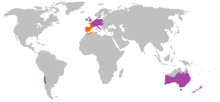
| |
| Range map: Native Introduced
| |
The European rabbit (Oryctolagus cuniculus) or coney[3] is a species of rabbit native to southwestern Europe (including Spain, Portugal and Western France) and to northwest Africa (including Morocco and Algeria).[4] It has been widely introduced elsewhere, often with devastating effects on local biodiversity. However, its decline in its native range (caused by the diseases myxomatosis and rabbit calicivirus, as well as overhunting and habitat loss), has caused the decline of its highly dependent predators, the Iberian lynx and the Spanish imperial eagle. It is known as an invasive species because it has been introduced to countries on all continents with the exception of Antarctica, and caused many problems within the environment and ecosystems. Australia has the most problems with European rabbits, due to the lack of natural predators there.
The European rabbit is well known for digging networks of burrows, called warrens, where it spends most of its time when not feeding. Unlike the related hares (Lepus spp.), rabbits are altricial, the young being born blind and furless, in a fur-lined nest in the warren, and they are totally dependent upon their mother. Much of the modern research into wild rabbit behaviour was carried out in the 1960s by two research centres. One was the naturalist Ronald Lockley, who maintained a number of large enclosures for wild rabbit colonies, with observation facilities, in Orielton, Pembrokeshire. Apart from publishing a number of scientific papers, he popularised his findings in a book The Private Life of the Rabbit, which is credited by Richard Adams as having played a key role in his gaining "a knowledge of rabbits and their ways" that informed his novel Watership Down. The other group was the Commonwealth Scientific and Industrial Research Organisation (CSIRO) in Australia, where numerous studies of the social behavior of wild rabbits were performed. Since the onset of myxomatosis, and the decline of the significance of the rabbit as an agricultural pest, few large-scale studies have been performed and many aspects of rabbit behaviour are still poorly understood.
Naming and etymology
Because of its non-British origin, the species doesn't have any native names in English or Celtic, with the usual terms "cony" and "rabbit" being foreign loanwords. "Rabbit" is also pronounced as rabbidge, rabbert (North Devon) and rappit (Cheshire and Lancashire). More archaic pronunciations include rabbette (15th-16th centuries), rabet (15th-17th centuries), rabbet (16th-18th centuries), rabatte (16th century), rabytt (17th century) and rabit (18th century). The root word is the Walloon rabett, which was once commonly used in Liège. Rabett itself is derived from the Middle Dutch robbe, with the addition of the suffix -ett.[5]
The term "cony" or "coney" predates "rabbit", and first occurred during the 13th century to refer to the animal's pelt. Later, "cony" referred to the adult animal, while "rabbit" referred to the young. The root of "cony" is the old French connil or counil, of which the Norman plural was coniz, and later conis. Its forerunner is the Greek κὐνικλος, from which the Latin cuniculus is derived. The origin of κὐνικλος itself is unclear: Ælian, who lived during the 3rd century, linked the word to the Basque unchi, while Varo and Pliny connected it to cuneus, which refers to a wedge, thus making reference to the animal's digging ability.[5]
The species' dwelling place is termed a warren or cony-garth. "Warren" comes from the Old English wareine, itself derived from the Old French warenne, varenne, or garenne. The root word is the Low Latin warenna, which originally signified a preserve in general, only to be later used to refer specifically to an enclosure set apart for rabbits and hares.[6] "Cony-garth" derives from the Middle English conygerthe, which may be a compound of connynge+erthe (cony+earth). The term stems from the Old French conniniere or coninyere, and later conilliere. The root word is the Low Latin cunicularia, the feminine form of the adjective cunicularius, which pertains to the rabbit.[5]
Taxonomy

Though originally assigned to the genus Lepus, the European rabbit was consigned to its own genus in 1874, on account of its altricial young, burrowing habits, and numerous skeletal characters.[7] The European rabbit is superficially similar to the North American cottontails, as both Oryctolagus and Sylvilagus are born blind and naked, have white flesh, and little sexual dimorphism. However, the two differ in skull characteristics, and cottontails do not habitually construct their own burrows as the European rabbit does.[8] Molecular studies confirm that the resemblance between the two is due to convergent evolution, and that the European rabbit's closest relatives are the hispid hare, the riverine rabbit and the Amami rabbit.[9] The oldest known fossils attributed to the modern European rabbit species are around 0.5 Ma old (Middle Pleistocene).[10]
Subspecies
As of 2005[update],[11] six subspecies are recognised.
| Subspecies | Trinomial authority | Description | Range | Synonyms |
|---|---|---|---|---|
| Common rabbit O. c. cuniculus |
Linnaeus, 1758 | Native to most of Europe except eastern, northern and alpine regions with long-lasting snowfall
Introduced to Australia, New Zealand, Chile, Africa, and several Atlantic and Pacific islands |
fodiens (Gray, 1867) kreyenbergi vermicula vernicularis | |
| Iberian rabbit O. c. algirus |
Loche, 1858 | Native to Portugal, southern Spain, North Africa, and Mediterranean and Atlantic islands | ||
| Mediterranean rabbit O. c. huxleyi |
Haeckel, 1874 | Derived from O. c. cunigulus, its size varies from large, hare-like individuals on Desertas, to dwarf forms on Salvages.[12] The rabbits of Madeira are ⅓ the weight of their mainland counterparts, and have more reddish upper parts and greyer lower surfaces.[13] | Introduced to warm Atlantic islands, including Madeira (by Gonçalves Zarco in 1418), Desertas, the Salvage Islands, and the Azores | |
| Cretan rabbit O. c. cnossius |
Bate, 1906 |
A small subspecies, similar to O. c. huxleyi.[14] | Native to Crete | |
| Camargue rabbit O. c. brachyotus |
Trouessart, 1917 | Native to salt marshes of Camargue, southern France | ||
| African rabbit O. c. habetensis |
Cabrera, 1923 | Native to Morocco, Straits of Gibraltar to Lau, Yebala, and Western Sahara | oreas (Cabrera, 1923) |
Description
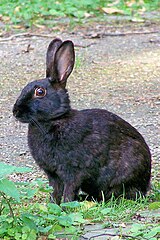


The European rabbit is smaller than the brown and mountain hare, and lacks black ear-tips, as well as having proportionately shorter legs.[16] An adult European rabbit can measure 40 centimetres (16 in) in length, and weigh 1,200–2,000 grams (2.6–4.4 lb). The hind foot measures 8.5–10 centimetres (3.3–3.9 in) in length, while the ears are 6.5–7.5 centimetres (2.6–3.0 in) long from the occiput.[17]
Size and weight varies according to food and habitat quality, with rabbits living on light soil with nothing but grass to feed on being noticeably smaller than specimens living on highly cultivated farm-lands with plenty of roots and clover. Pure European rabbits weighing 5 kilograms (11 lb) and upwards are uncommon, but are occasionally reported. One large specimen, caught in February 1890 in Lichfield, was weighed at 2.8 kilograms (6 lb 2 oz).[18] Unlike the brown hare, the male European rabbit is more heavily built than the female.[19] The penis is short, and lacks a baculum and true glans.[7]
The fur of the European rabbit is generally greyish-brown, but this is subject to much variation. The guard hairs are banded brown and black, or grey, while the nape of the neck and scrotum are reddish. The chest patch is brown, while the rest of the underparts are white or grey. A white star shape is often present on kits' foreheads, but rarely occurs in adults. The whiskers are long and black, and the feet are fully furred and buff-coloured.[7] The tail has a white underside, which becomes prominent when escaping danger. This may act as a signal for other rabbits to run.[18]
Moulting occurs once a year, beginning in March on the face and spreading over the back. The underfur is completely replaced by October-November.[7] The European rabbit exhibits great variation in colour, from light sandy, to dark grey and completely black. Such variation depends largely on the amount of guard hairs relative to regular pelage. Melanists are not uncommon in mainland Europe, though albinoes are rare.[15]
Life history and behaviour
Social and territorial behaviours

The European rabbit lives in warrens that contain 2-10 other individuals living in smaller groups to ensure greater breeding success.[20] Territoriality and aggression contribute greatly to the rabbits' maturation process, and help ensure survival of the population.[21] Females tend to be more territorial than males, although the areas most frequented by females are not defended.[22] Territories are marked with dung hills.[23] The size of the species' home range varies according to habitat, food, shelter, cover from predators, and breeding sites, though it is generally small, encompassing about 0.3-0.7 hectares. Except during times of low rabbit density and abundance of high-quality food, male ranges tend to be larger than those held by females. The European rabbit rarely strays far from its burrow: when feeding on cultivated fields, it typically only moves 25 metres away from its burrow, and rarely 50 metres. It may however move as far as 500 metres after an abrupt change in environment, such as a harvest. This behaviour may be an anti-predator adaptation, as rabbits in areas where predators are under rigorous control may move three times further from their burrows than those in areas without predator management.[24]
The European rabbit is a gregarious animal, which lives in stable social groups centred around females sharing access to one or more burrow systems. However, social structures tend to be looser in areas where burrow construction is relatively easy. Dominance hierarchies exist in parallel for both bucks and does. Among bucks, status is determined through access to does, with dominant bucks siring the majority of the colony's offspring. The dominant does have priority access to the best nesting sites, with competition over such sites often leading to serious injury or death. Subordinate does, particularly in large colonies, typically resort to using single-entrance breeding spots far from the main warren, thus making themselves vulnerable to fox or badger predation.[24]
Reproduction and development

The rabbit mating system is rather complex: dominant bucks exhibit polygyny, whereas lower-status individuals (both bucks and does) often form monogamous breeding relationships. Rabbits signal when they are ready to copulate by marking inanimate objects while giving off odoriferous substances though their chin gland, a process known as "chinning".[25] Though usually amicable to one another outside the breeding season, once it begins, fierce fights erupt among the bucks.[26] The breeding season typically occurs in January-August, during which time a succession of litters (usually 3-7 kittens) are produced at intervals of at least 30 days. In overpopulated areas, pregnant does may lose all their embryos through intrauterine absorption.[27] Shortly before giving birth, does construct separate burrows known as "stops" or "stabs", generally in open fields away from the main warren. These breeding burrows are typically a few feet long, and lined with grass, moss, and fur plucked from the does' belly. The breeding burrows are probably dug in order to protect kittens from adult bucks, as well as predators.[28]
The gestation period lasts for 30 days,[29] with the sex ratio of male and female kittens tending to be 1:1, though greater maternal investment over male offspring results in higher birth weights for bucks.[27] Kittens born from the dominant buck and doe tend to grow larger, stronger and more dominant than those born from subordinate rabbits, as they have the advantages of having been born in the best nesting and feeding grounds.[30] It is not uncommon for does to mate again immediately after giving birth, with some specimens having been observed to nurse previous young whilst pregnant.[29] The doe nurses its kittens once a night for only a few minutes. After suckling is complete, the doe seals the entrance to the stop with soil and vegetation. In the species' original Iberian and southern French range, the kittens' growth rate is 5 grams per day, though populations introduced elsewhere grow at a rate of 10 grams per day. Birth weight is 30-35 grams, and increases to 150-200 grams 21-25 days later during the weaning period.[27] The kittens are born blind, deaf, and nearly naked. The ears do not gain the power of motion until ten days of age, and can be erected after thirteen. The eyes open eleven days after birth.[29] The kittens begin to leave the burrow at the age of 18 days. Sexual maturity in bucks is attained at the age of four months, while does can breed at 3-5 months.[27]
Burrowing behaviour
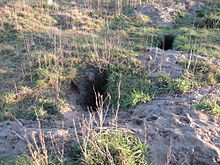
The European rabbit's burrows occur mostly on slopes and banks, where drainage is more efficient. The burrow entrances are typically 10-50 cm in diameter,[16] and are easily recognisable by the bare earth at their mouths. Vegetation growth is prevented by the constant passing and repassing of the resident rabbits. Big burrows are complex excavations which may descend to depths of several feet. They are not constructed on any specified plan, and appear to be enlarged or improved as a result of the promiscuous activity of several generations. Digging is done by pulling the soil backwards with the forefeet and throwing it between the hind legs, which scatter the material with kicking motions. While most burrows are dug from the outside, some warrens feature holes dug from the inside which act as emergency exits when escaping from predators below ground. These holes usually descend perpendicularly to 3-4 feet, and their mouths lack the bare earth characteristic of burrow entrances. While kittens sleep in chambers lined with grass and fur, adults sleep on the bare earth, likely in order to prevent damp, with warmth being secured by huddling.[31] Although both sexes dig, does do so more skillfully, and for longer periods.[32]
Communication
The European rabbit is usually a silent animal, though it has at least two vocalisations. The most well known is a high treble scream or squeal.[33] This distress call has been variously likened to the cry of a bat[34] or piglet. This sound is uttered when in extreme distress, such as being caught by a predator or trap.[33] During the spring, bucks express contentment by emitting grunting sounds when approaching other rabbits. These grunts are similar to shrill hiccups, and are emitted with the mouth closed. Aggression is expressed with a low growl.[34]
Ecology
Habitat
The European rabbit's ideal habitat consists of short grasslands with secure refuge (such as burrows, boulders, hedgerows, scrub and woodland) near feeding areas. It may dwell up to treeline, as long as the land is well drained and shelter is available. The size and distribution of its burrow systems depend on the type of soil present: in areas with loose soil, it selects sites with supporting stuctures, such as tree roots or shrubs in order to prevent burrow collapse. Warrens tend to be larger and have more interconnected tunnels in areas with chalk than those in sand. In large coniferous plantations, the species only occurs on peripheral areas and along fire breaks and rides.[35]
Diet
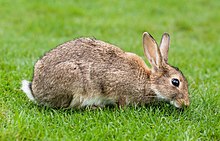
The European rabbit eats a wide variety of herbage, especially grasses, favouring the young, succulent leaves and shoots of the most nutritious species, particularly fescues. In mixed cultivated areas, winter wheat is preferred over maize and dicotyledons. During the summer period, the European rabbit feeds on the shortest, and therefore less nutritious grass swards, thus indicating that grazing grounds are selected through anti-predator considerations rather than maximising food intake. In times of scarcity, the rabbit increases its food intake, selecting the parts of the plant with the highest nitrogen content.[36] Hungry rabbits in winter may resort to eating tree bark. Blackberries are also eaten, and captive-bred European rabbits have been fed on fodder consisting of furze and acorns, which can lead to considerable weight gain.[37] The European rabbit is a less fussy eater than the brown hare: when eating root vegetables, the rabbit eats them whole, while the hare tends to leave the peal.[38] Depending on the body's fat and protein reserves, the species can survive without food in winter for about 2-8 days.[36] Although herbivorous, cases are known of rabbits eating snails.[37]
Like other leporids, the European rabbit produces soft, mucus-covered faecal pellets, which are ingested directly from the anus.[36] The soft pellets are produced posterior to the colon in the hind-gut soon after the excretion of hard pellets and the stomach begins to fill with newly-grazed food. The soft pellets are filled with protein-rich bacteria, and pass down to the rectum in glossy clusters. The rabbit swallows them whole, without perforating the enveloping membrane.[39]
Predators
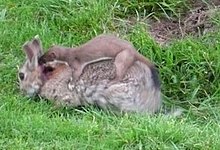
The European rabbit is prey to many different predatory species. Foxes, dingoes, wolves, lynxes, wolverines and dogs kill both adult and young rabbits by stalking and surprising them in the open. However, relatively few rabbits are caught this way, as rabbits can quickly rush back to cover with a burst of speed. Both foxes and badgers will dig out kittens from shallow burrows, with the latter predators being too slow to catch adult rabbits. Both wild and domestic cats will stalk and leap upon rabbits, particularly young specimens leaving their burrows for the first time.[40] Wildcats take rabbits according to availability: in eastern Scotland, where rabbits are abundant, they can comprise over 90% of the wildcats' diet.[17] Most domestic cats are incapable of killing healthy, full-grown adults, but will take weak and diseased ones. Does can be fiercely protective of their kittens, having been observed to chase away large cats and mustelids, including ferrets, stoats and weasels. However, rabbits typically run from mustelids, and may fear them innately. Cases are known of rabbits becoming paralysed with fear and dying when pursued by stoats or weasels, even when rescued unharmed.[40] It is known that the European rabbit comprises 85% of the polecat's diet, and its availability is important to the success of breeding female mink.[17] Brown rats can be a serious threat to kittens, as they will reside in rabbit burrows during the summer, and attack them in groups.[41][42] Although many birds of prey are capable of killing rabbits, few are strong enough to carry them. Large species, such as golden and sea eagles, may carry rabbits back to their nests, while small eagles, buzzards and harriers struggle to do so. Hawks and owls typically only carry off very small kittens.[40]
Human relationship with rabbits
Recent research has shown that all European rabbits carry common genetic markers and descend from one of two maternal lines. These lines originated between 12,000 and 6.5 million years ago, when glaciers isolated two herds; one on the Iberian Peninsula and the other in Southern France. It can be surmised that humans began hunting rabbits as a food source, but further research needs to be done to verify this. Little comprehensive evidence of the relationship of humans with European rabbits is documented until the medieval period.[43]
Humans' relationship with the European (sometimes called "true") rabbit was first recorded by the Phoenicians prior to 1000 BC, when they termed the Iberian Peninsula i-shaphan-ím (literally, the land of the hyraxes). This phrase closely resembles related modern Hebrew: i (אי) meaning island and shafan (שפן) meaning hyrax, plural shfaním (שפנים). Phoenicians called the local rabbits 'hyraxes' because rabbits resemble hyraxes in some ways, and hyraxes are native to Phoenicia, unlike rabbits. Hyraxes, like rabbits, are not rodents. One theory states that the Romans converted the phrase i-shaphan-ím, with influence from the Greek Spania, to its Latin form, Hispania, which evolved into the modern Spanish word España (English "Spain"), and such other variations in modern languages. The precise meaning of shafan remains unclear, but the balance of opinion appears to indicate that the hyrax is indeed the intended meaning.[44]
Like the Phoenicians, neither the later Greek nor Roman colonizers had a specific name for the rabbit, because the species is not native to Greece and Italy (though it is present there nowadays). They commonly called it "small hare" and "small digging hare", in contrast to the European hare, which is larger and doesn't make burrows. Catullus used the name cuniculus (a latinization of the Iberian word kiniklos[45] and the etymological origin of the Spanish name conejo[46] and the old English name, coney[47]), and referenced its abundance in Celtiberia by calling this region cuniculosa, i.e. rabbit-ridden.[48][49]
The European rabbit is the only rabbit species that has been domesticated. All pet breeds of rabbits, such as Mini Lops and Angoras, are of this species. However, rabbits and humans interact in many different ways beyond domestication. Rabbits are an example of an animal treated as a food, pet, and pest by members of the same culture. Urbanized European rabbits descended from pets have become pest problems in some cities. For instance, one of the northernmost populations of the species is now hosted by Helsinki, Finland, with an estimated 2,500 animals at the end of 2006 and 5,000 in autumn 2007.[50] Finland's native lagomorphs are the European hare and the mountain hare. In Iceland, populations of O. cuniculus are also found in Reykjavik and in the Vestmann Islands.
As an invasive species

The European rabbit has been introduced as an exotic species into several environments, often with harmful results to vegetation and local wildlife, making it an invasive species. The first known mention of the rabbit as an invasive species (and possibly the first documented instance of an invasive species ever) was made in regard to the introduction of the rabbit to the Balearic Islands after the Roman conquest of the 1st century BCE. According to both Strabo and Pliny the Elder, the multiplying rabbits caused famines by destroying crop yields, and even collapsed trees and houses with their burrowing. The inhabitants petitioned Augustus for help, who sent troops to curb the rabbit population with the help of ferrets.[48][49]
Other locations where rabbits were introduced by humans include Great Britain, where they were first introduced by the Romans following their invasion in AD 43;[51] (in November 2004 there were about 40 million European rabbits in the British Isles), Laysan Island (1903) and Lisianski Island in the Hawaiian Islands; Macquarie Island; Smith Island, San Juan Island (around 1900) later spreading to the other San Juan Islands; several islands off the coast of Southern Africa, one well-known example being that of Robben Island; Australia and New Zealand.[citation needed]
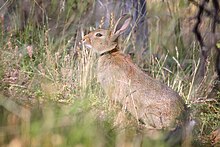
in Victoria (Australia)
Twenty-four European rabbits were introduced to Australia in 1859 by estate owner Thomas Austin in Victoria. They soon spread throughout the country due to the lack of natural predators, widespread farming producing an ideal habitat, and mild Australian winters allowing them to breed year-round. Australia's equivalent to the rabbit, the bilby, was quickly pushed out by the rabbits. The bilbies are endangered, but are now making a comeback due to government protection. Between 1901 and 1907, Australia built an immense "rabbit-proof fence" to halt the westward expansion of the introduced rabbit population. The European rabbit can not only jump very high, but also burrow underground, making fencing essentially futile. During the 1950s, experiments with introduction of a virus, Myxomatosis cuniiculi, provided some relief in Australia, but not in New Zealand, where the insect vectors necessary for spread of the disease were not present. Myxomatosis can also infect pet rabbits of the same species. Today's remaining wild rabbits in Australia are largely immune to myxomatosis. The rabbit haemorrhagic disease virus has been cleared as a biological control agent against the European rabbit in Australia, and has already killed millions of the animals. It was also illegally introduced in New Zealand.

A non-native species, rabbits were introduced to the island following World War II as part of the development of a park. The rabbits established a self-sustaining population on Ōkunoshima over the latter half of the 20th century.
Domesticated rabbits
The only rabbit to be widely domesticated is the European rabbit, which has been extensively domesticated for food or as a pet. It was first widely kept in ancient Rome, where foetal rabbits were known as laurices and considered a delicacy, and has been refined into a wide variety of breeds during and since the Middle Ages.
Domesticated rabbits have mostly been bred to be much larger than wild rabbits, though selective breeding has produced a range sizes from "dwarf" to "giant", which are kept as food animals and pets across the world. They have as much colour variation among themselves as other livestock and pet animals. Their fur is prized for its softness; today, Angora rabbits are raised for their long, soft fur, which is often spun into yarn. Other breeds are raised for the fur industry, particularly the Rex, which has a smooth, velvet-like coat and comes in a wide variety of colors and sizes.
Conservation status
In 2005, the Portuguese Institute for Nature Conservation and Forests (ICNB) classified Oryctolagus cuniculus in Portugal as "Near Threatened",[52] while in 2006, Spanish authorities (SECEM) reclassified it in Spain as "Vulnerable".[53] In 2008, the International Union for the Conservation of Nature (IUCN) reclassified Oryctolagus cuniculus in its entire native range as "Near Threatened", due to the extent of recent declines.[54]
See also
- Cuniculture, on the practice of breeding and raising the domesticated version of the European rabbit
- List of breeds of the domesticated version of the European rabbit
- Rabbits in Australia, on the effect of the invasive European rabbit in Australia
References
- ^ Hoffman, R.S.; Smith, A.T. (2005). "Order Lagomorpha". In Wilson, D.E.; Reeder, D.M (eds.). Mammal Species of the World: A Taxonomic and Geographic Reference (3rd ed.). Johns Hopkins University Press. pp. 205–206. ISBN 978-0-8018-8221-0. OCLC 62265494.
- ^ Smith, A.T.; Boyer, A.F. (2008). "Oryctolagus cuniculus". IUCN Red List of Threatened Species. 2008. IUCN: e.T41291A10415170. doi:10.2305/IUCN.UK.2008.RLTS.T41291A10415170.en. Retrieved 27 August 2016.
- ^ "coney, n.1". OED Online. Oxford University Press. 1 March 2018. Retrieved 25 April 2018.
- ^ "ADW: Oryctolagus cuniculus: INFORMATION". Animal Diversity Web.
- ^ a b c Barrett-Hamilton, Hinton & Wilson 1910, pp. 177–179
- ^ Harting 1898, pp. 51–52
- ^ a b c d Harris & Yalden 2008, pp. 203
- ^ Barrett-Hamilton, Hinton & Wilson 1910, pp. 173
- ^ Harris & Yalden 2008, pp. 201
- ^ The Lagomorph Fossil Record and the Origin of the European Rabbit by Nieves Lopez-Martinez, 2008, Springer Berlin Heidelberg, Print ISBN 978-3-540-72445-2
- ^ Wozencraft, W. C. (2005). "Order Carnivora". In Wilson, D. E.; Reeder, D. M. (eds.). Mammal Species of the World: A Taxonomic and Geographic Reference (3rd ed.). Johns Hopkins University Press. ISBN 978-0-8018-8221-0. OCLC 62265494.
- ^ Lockley 1976, pp. 146
- ^ Harting 1898, pp. 15
- ^ Barrett-Hamilton, Hinton & Wilson 1910, pp. 199
- ^ a b Harris & Yalden 2008, pp. 204–205
- ^ a b Harris & Yalden 2008, pp. 202
- ^ a b c Harris & Yalden 2008, pp. 204
- ^ a b Harting 1898, pp. 13–15
- ^ Barrett-Hamilton, Hinton & Wilson 1910, pp. 199–201
- ^ Daly, J. C. (1981). "Effects of Social Organization and Environmental Diversity on Determining the Genetic Structure of a Population of the Wild Rabbit, Oryctolagus cuniculus." Evolution 35(4): 689-706.
- ^ Dudzinski, M. L., R. Mykytowycz, et al. (1977). "Behavioral Characteristics of Adolescence in Young Captive European Rabbits, Oryctolagus cuniculus." Aggressive Behavior 3: 313-330.
- ^ Vastrade, F. M. (1987). "Spacing Behavior of Free-Ranging Domestic Rabbits, Oryctolagus cuniculus L." Applied Animal Behaviour Science 18:185-195.
- ^ Mykytowycz, R. and M. L. Dudzinski (1972). "Aggressive and Protective Behaviour of Adult Rabbits Oryctolagus cuniculus (L.) Towards Rabbits." Behaviour 43: 97-120.
- ^ a b Harris & Yalden 2008, pp. 206–207
- ^ Gonzalez-Mariscal, G., M. E. Albonetti, et al. (1997). "Transitory inhibition of scent marking by copulation in male and female rabbits." Animal Behavior 53:323-333.
- ^ Lockley 1976, pp. 97
- ^ a b c d Harris & Yalden 2008, pp. 207–209
- ^ Barrett-Hamilton, Hinton & Wilson 1910, pp. 214
- ^ a b c Barrett-Hamilton, Hinton & Wilson 1910, pp. 210–212
- ^ Lockley 1976, pp. 100
- ^ Barrett-Hamilton, Hinton & Wilson 1910, pp. 202–205
- ^ Lockley 1976, pp. 58
- ^ a b Lockley 1976, pp. 23
- ^ a b Barrett-Hamilton, Hinton & Wilson 1910, pp. 227
- ^ Harris & Yalden 2008, pp. 206
- ^ a b c Harris & Yalden 2008, pp. 207
- ^ a b Barrett-Hamilton, Hinton & Wilson 1910, pp. 225
- ^ Harting 1898, pp. 6
- ^ Lockley 1976, pp. 104–105
- ^ a b c Lockley 1976, pp. 139–142
- ^ Harting 1898, pp. 39
- ^ Barrett-Hamilton, Hinton & Wilson 1910, pp. 212
- ^
"History of Rabbit Domestication -- Western Europe". Archived from the original on 2011-07-11.
{{cite web}}: Unknown parameter|deadurl=ignored (|url-status=suggested) (help) - ^
"The Camel, the Hare and the Hyrax, chapter 6" (PDF). Archived from the original (PDF) on 16 June 2012.
{{cite web}}: Unknown parameter|deadurl=ignored (|url-status=suggested) (help) - ^ "ORIGEN IBÉRICO DEL CONEJO". studylib.es.
- ^ http://dle.rae.es/srv/search?m=30&w=conejo
- ^ "Definition of CONEY". www.merriam-webster.com.
- ^ a b López Seoane, V. (1861) Fáuna Mastológica de Galicia, ó historia natural de los mamíferos de este antiguo Reino, aplicada á la medicina, á la agricultura, á la industria, á las artes y al comercio. Manuel Mirás, 544 pages.
- ^ a b Blázquez, J.M. (1975) La romanización. Ediciones AKAL, 437 pages.
- ^ Kemppainen, Jouni K. (October 2007). "Kanit keskuudessamme (The rabbits among us)". Suomen Kuvalehti (in Finnish): 76–83.
- ^ "Norfolk - Remains of Roman rabbit uncovered". BBC News.
- ^ Livro Vermelho dos Vertebrados de Portugal ("Red Book"). Instituto da Conservação da Natureza (ICNF). 12 December 2005. ISBN 972-775-153-9. Retrieved 29 March 2018.
- ^ "SECEM 2006 red list" (PDF). secem.es. Archived from the original (PDF) on 2007-10-06.
{{cite web}}: Unknown parameter|deadurl=ignored (|url-status=suggested) (help) - ^ "The IUCN Red List of Threatened Species™: Oryctolagus cuniculus". IUCN (International Union for Conservation of Nature) (1 March 2017 ed.). 30 June 2008. ISSN 2307-8235. Retrieved 29 March 2018.
Bibliography
- Barrett-Hamilton, Gerald Edwin Hamilton; Hinton, Martin A. C.; Wilson, Edward Adrian (1910). A history of British mammals, v. 2; pt. 2. London : Gurney and Jackson.
{{cite book}}: Invalid|ref=harv(help) - Harris, Stephen; Yalden, Derek (2008). Mammals of the British Isles. Mammal Society; 4th Revised edition edition. ISBN 0-906282-65-9.
{{cite book}}: Invalid|ref=harv(help) - Harting, James Edmund; Shand, A. I. (1898). The rabbit; with a chapter on Cookery. London, Longmans.
{{cite book}}: Invalid|ref=harv(help) - Lockley, R. M. (1976). The Private Life of the Rabbit. Readers Union Group of Book Clubs.
{{cite book}}: Invalid|ref=harv(help)
External links
- View the rabbit genome in Ensembl
- View the oryCun2 genome assembly in the UCSC Genome Browser.
- IUCN Red List near threatened species
- Mammals described in 1758
- Fauna of Gibraltar
- Introduced animals of Hawaii
- Mammals of Europe
- Mammals of North Africa
- Rabbits and hares
- Invasive animal species in Europe
- Invasive animal species of the British Isles
- Invasive animal species in England
- Invasive animal species of Italy
- Invasive animal species of Sweden
- Introduced animals of Europe
- Invasive animal species in North America
- Invasive animal species in the United States
- Invasive animal species of South America
- Invasive animal species of Argentina
- Invasive animal species in Oceania
- Invasive animal species in Australia
- Invasive animal species in New Zealand

